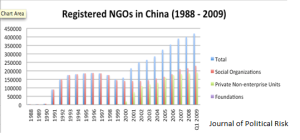Journal of Political Risk, Vol. 1, No. 8, December 2013.
By Ruge Gao

Figure 1. Registered NGOs (Civil Organizations) in China 1988 to 2009. Data source: Xu Ying and Zhao Litao, 2013.
With China’s impressive economic growth over the past few decades has come an environmental cost that reaches from the countryside to the capital.[1] While some Chinese economists believe the lack of environmental regulation encourages uninhibited growth, the Chinese State Environmental Protection Agency and State Statistics Bureau have produced statistics that indicate that environmental damages have decreased growth by three percent.[2] Triggered most prominently by the 1998 Yangtze River Floods, the number of Chinese environmental non-governmental organizations (ENGOs) began growing around 2000 and experienced explosive growth within the last decade. According to Chinese Ministry of Civil Affairs statistics,[3] in 2008 China had approximately 212,000 social groups, with 5,330 being of the environmental variety. Many Chinese ENGOs are in the public eye, but must simultaneously satisfy international donors and local government officials in order to survive.
Non-governmental organizations (NGOs) are not recorded as an independent category from social groups, an overarching category that includes civil organizations, foundations, and civilian-run non-corporate organizations and NGOs.[4] As can be seen in Figure 1[5] and Table 1,[6] the booming number of domestic NGOs is truly spectacular. The country went from having zero domestic NGOs before 1994 to having 414,614 non-governmental organizations in the first quarter of 2009.[7]

Table 1. Registered NGOs (Civil Organizations) in China 1988 to 2009. Data source: Xu Ying and Zhao Litao, 2013.
Three factors are fundamental to the birth, growth, survival, and influence of Chinese ENGOs: connections to the state administration, funding from corporate foundations, and the ability to promote public awareness through social and official media. Perhaps due to the fact that NGOs are a relatively new social phenomenon, the central government has not given them official legal status as “non-governmental organizations”.[8] NGOs in China typically exist as “civil organizations” or commercial companies subject to taxation on collected donations. They must be supervised and sponsored by state-run administrative agencies.[9] This can become problematic if grassroots NGOs cannot find sponsors, especially if the NGO’s activity could be construed by the State as instigating political dissent. ENGOs with connections to government are relatively more apt to survive, simply from the benefit of being established as legitimately registered organizations through affiliations with government agencies. Through the powers of public media, ENGOs are capable of spreading environmental awareness and promoting their environmental and ecological goals. This can help attract potentially interested volunteer groups and donors.[10]
International NGOs (INGOs) and corporations have gained major public relations benefits by providing Chinese ENGOs with financial aid. The Caterpillar Foundation’s environmental ventures, for example, provide audiences in both the United States and China with an image of corporate social responsibility. The Chinese trade magazine, China Science and Technology Fortune, depicted Caterpillar in 2006 as greedy and destructive of China’s heavy machinery markets: “… strings of corporate mergers and dealings with executives in the heavy machinery industry … has attracted the attention of many Chinese officials on the government, corporate, media, and public level with its strategies regarding China.”[11] During 2011 and 2012, perhaps in response to this and other negative attention, the Caterpillar Foundation partnered with China Environmental Protection Foundation (CEPF) in a project to build forest lots in four locations across North China.[12] Throughout their collaborative efforts, Caterpillar and CEPF invited volunteer groups from local schools to participate in the planting of trees, attracting numerous news agencies to witness and report on their efforts in greening several deforested suburbs.
Via publicity channels in local and national media, Caterpillar benefited in both bettering its corporate image among Chinese consumers, and by earning a fair amount of positive exposure of its efforts to improve China’s environment. The corporation succeeded in humanizing itself with the public as an establishment that cares not only for profit, but for contributing to the well being of the Chinese public. The media strategy was a brilliant public relations campaign in which Caterpillar won approval from the Chinese media and those reached by the media coverage, and CEPF completed a successful project with a major Western corporation and won some share of the positive publicity coverage as well.
International NGOs have also invested large amounts of resources (economic and otherwise) in the development of Chinese NGOs. In fact, INGOs are one of the greatest supporters of Chinese NGOs through the financial grants and technical training they provide.[13] Indeed, many Chinese ENGOs use foreign sources for most of their funding.[14] As might be expected, not all contributions to the growth of Chinese ENGOs, are viewed with friendly eyes. Perhaps due to the fact that NGOs are (by definition) non-governmental at the root of their organizational structure, and NGOs are indeed a new occurrence in China’s history, many in the Chinese government still warily view foreign NGO investments as potential political threats.[15]
A major concern is that investments from INGOs may lead INGOs to have a sense of entitlement in reorganizing or changing the goals of the Chinese ENGOs, including bias against the Chinese government. Regardless of whether or not this is true, some Chinese NGOs certainly complain that international donors use their financial power to pursue their agendas through the Chinese organizations. For their part, international organizations also complain that the promises of Chinese NGOs frequently outweigh the delivery.[16]
Besides domestic problems with bureaucratic registration as civil social organizations and fundraising obstacles, ENGOs face harsh difficulties in proper litigation against corporations with lax environmental procedures. The reason for this difficulty can be traced to the infancy of Chinese public interest litigation. Public interest litigation has been for some time a concept discussed among reporters and academics, but no case regarding environmental violation of public welfare has yet been fully won; only small breakthroughs have been achieved in previously unexplored legal arenas.[17]
For example, the past decade has seen improvement in environmental litigation with the official registration of the 2009 heavy air pollution case of Jiangsu Jiangyin Container Co. Ltd., a registration in formal court previously impossible for public-interest cases. In 2009, only four courts in China were open to accepting environmental litigation, one of them being the Wuxi court that participated in the process of the Jiangsu Jiangyin case. Though relevant environmental laws have been established in 2009, and the Wuxi court welcomed litigation from ENGOs, nobody before the Jiangyin Jiangsu case had wanted to bear the burden of trailblazing these new legal grounds. After all, ENGOs themselves were a relatively new social phenomenon in China. Actual results were limited in quality, as court officials and pro bono lawyers took extreme care in processing the case, as well as much time in processing paperwork. Even though Jiangyin Container Company received a court case as well as a required examination of pollutants by the environmental officials, the company still began heavy pollutant operations, since legal procedures were underway.
For smaller Chinese towns and regions, industrial plants and factories causing severe pollution may often be the backbone of the entire local economy, making officials reluctant to correctly discipline companies and enforce strict environmental laws. Local governments face a dilemma: the health of their population versus the gross domestic product (GDP) of their economy. Environmental litigation has become for many parties a crushing burden – a complicated quandary of hesitant government officials, heavy prosecution costs for which ENGO members cannot pay, and a dearth of Chinese public interest lawyers. Most lawyers associated with large Chinese ENGOs provide pro bono legal services for public causes, because ENGOs cannot afford legal fees. The problems faced by people who wish to pursue environmental litigation mirrors the wall of difficulties ENGO members have faced in registering their groups as formal organizations. The core of both sets of obstacles is the hesitance of some government officials to affiliate their names to enterprises that do not provide direct and quick returns in visible economic growth.
Others have viewed the recent attempted prosecutions of polluters by ENGOs with optimism. Spectators of environmental litigation have asserted that Chinese ENGOs could be achieving two major objectives. Success in environmental litigation itself would be a groundbreaking development for public interest litigation in China, as public interest lawsuits have not yet been proven as legitimate or practical. The success of such a lawsuit would legitimize the lead ENGO as something more than the current perception: a grassroots organization merely capable of voicing complaints through social and news media against companies that illegally dump chemical waste.[18]
But acquiring the necessary evidence to litigate is incredibly difficult. Chinese ENGOs have significant problems in employing ecologists and environmental scientists to assist them in formally evaluating and scientifically proving the severity of environmental damage and the case for suing offending industrial corporations. The largest non-registered Chinese ENGO, Friends of Nature (FoN), encountered numerous such obstacles. The most staggering are the fees charged by government agencies for use of their ecological services.
For example, government agencies attempted to charge FoN 7 million RMB (1.14 million USD) to determine the severity of the polluted area of Pearl River Qujing, Yunnan Province, by Luliang Chemical Company.[19] FoN’s total annual income is only 5 million RMB, so they decided to acquire the ecological expertise in-house to evaluate the polluted area.[20] However, FoN officials were met with hostile self-proclaimed ‘security guards’ who forcefully took from FoN staff their cameras and other evidence, then deleted data before official policemen were able to return equipment and materials to FoN. Company and government officials refused to comment to the press on this incident.[21]
Due to the limited time frame and politically sensitive nature of ENGOs, the legislative and policy-making processes concerning ENGOs and civil organizations have been only intermittently successful.[22] As a result, legislation and government policies enacted do not provide the most hospitable environment for the flourishing of the NGO sector. [23] The Chinese government and representatives in legislative offices have made it clear to ENGOs and INGOs operating in China that it is appropriate and encouraged to promote environmental awareness and slow environmental deterioration in China, but that the ENGOs must strictly adhere to Chinese social and political etiquette.
Environmentalism in China is above all a “social movement with Chinese characteristics.”[24] Unlike environmental movements in Soviet Russia or Southeast Asia, where environmental campaigns have spurred political reforms, Chinese movements have played by government rules and are comparatively more interested in environmental awareness than domestic political reform. The central government is aware of the costs and dangers of environmental degradation. They cannot downplay the influence of international norms, and are thus willing to embrace partnership with fledgling ENGOs. This helps explain why Chinese ENGOs enjoy more room to maneuver than interest groups advocating for other objectives, such as the protection of workers’ rights.[25]
ENGOs in China have experienced explosive growth in the last two decades. They are increasing environmentalism in the public sphere, gaining increased support from lawyers and government agencies, and pressuring corporations and organizations to abide by environmental regulations. However, ENGOs are vulnerable and precariously perched between two masters with sometimes competing interests. They are often dependent on international funding, but their survival depends almost entirely on the strength of their relations with organs of the local and central Chinese government. NGOs must remain open to cooperation with Western organizations in their operations, and seek to increase support based on simple publicity measures, especially from younger Chinese generations.[26] As censorship remains a lasting issue in Mainland China and the majority of ENGOs survive by publicity on social media outlets, it is best and most efficient for them to leave debates about the functions of Chinese government entirely out of the equation.[27] Respect of the Chinese government’s operations and missions is vital for ENGO survival – a fact that both Chinese and Western ENGOs will eventually have to accept. INGOs of Western origin will achieve the most in their endeavors in China if positive and collaborative attitudes towards the Chinese administration are communicated clearly and repeatedly before and during operations. Environmentalism, if communicated without a political agenda, could be the green connection that links China with the rest of the world.
Ruge Gao is an undergraduate studying History, Literature and International Relations at Cornell University. A native of Beijing, she completed an internship and conducted research on environmental groups in Beijing in 2012 and 2013, including with the China Environmental Protection Foundation and the United Nations Development Program (UNDP). Dr. Anders Corr and Ms. Samantha Gay provided editorial oversight for this article. The Journal of Political Risk is published by Corr Analytics Inc., a New York based political risk consultancy.
JPR Status: Working Paper
[1] Yibo, Wang, “Suburbs ‘numbers flaring red’, Beijing ‘lightly polluted’? Beijing’s air quality has reached 498. According to Air Pollution Index, an indice of over 300 is considered severely polluted” China Youth Online, 1/24/2013, http://zqb.cyol.com/html/2013-01/14/nw.D110000zgqnb_20130114_2-01.htm, accessed 8/8/2013.
[2] Eva, Sternfeld, “Umwdtsituation lind Umweltpolitik in China”, in Aus Politik und Zeitgeschichte, 2006. 49 (12): 27-34.
[3] “Newest statistics regarding social organization development published by the Ministry of Civil Affairs,” Ministry of Civil Affairs of the People’s Republic of China, 6/20/2008, http://cbzs.mca.gov.cn/article/shxw/yw/200806/20080600017059.shtml, accessed 7/15/2013, n.a.
[4] Wang, Liao“The definition, features and categorization of social groups,” Xinhuanet, 9/12/2010, http://news.xinhuanet.com/politics/2010-09/12/c_12544379.htm, accessed 8/14/2013.
[5] Ying, Xu and Litao, Zhao, ‘China’s rapidly growing non-governmental organisations’, Singapore, EAI Background Brief No. 514, 2010, http://www.eai.nus.edu.sg/BB514.pdf, accessed 7/9/2013.
[6] Ying, Xu and Litao, Zhao, ‘China’s rapidly growing non-governmental organisations’, Singapore, EAI Background Brief No. 514, 2010, http://www.eai.nus.edu.sg/BB514.pdf, accessed 7/9/2013.
[7] Nan, Xu “The Life History of Chinese Environmental NGOs,” Southern Weekly, 10/8/2009, http://www.infzm.com/content/35571, accessed 6/16/2013.
[8] William, Ford, “NGOs from overseas are a growing force,” China Daily, 6/8/2012, http://europe.chinadaily.com.cn/epaper/2012-06/08/content_15486242.htm, accessed 7/18/2013.
[9] “Infant Stage: Chinese Environmental NGOs,” Southern Weekly, 1/7/2002, http://www.envir.gov.cn/info/2002/1/17337.htm, accessed 7/15/2013, n.a.
[10] “The Reason Behind the Vitality of Chinese Environmental NGOs,” Beijing Public Net for Environment Protection, 10/13/2004, http://www.bjee.org.cn/cn/news.php?news_id=5104, accessed 8/8/2013, n.a.
[11] Xiaolan, Wang, “Caterpillar’s China Strategies Under Resistance”, China Science and Technology Fortune, 6th issue 2006. http://wenku.baidu.com/view/a7d9f00403d8ce2f00662353.html, accessed 7/29/2013.
[12] “CEPF Launches ‘Caterpillar Charity Forest Plan 2012’,” China Environmental Protection Foundation, 4/24/2012, http://www.cepf.org.cn/jjhdt/201204/t20120424_226680.htm, accessed 7/15/2013, n.a.
[13] Björn, Alpermann, “State and Society in China’s Environmental Politics,” in China’s Environmental Crisis: Domestic and Global Political Impacts and Responses, edited by Joel Jay Kassiola and Sujian Guo, 123-151. Palgrave MacMillan, 2010.
[14] Björn, Alpermann, “State and Society in China’s Environmental Politics,” 2010.
[15] However, Chinese ENGOs specifically may appear to be less politically harmful than organizations concerned with human rights issues and social causes.
[16] Björn, Alpermann, “State and Society in China’s Environmental Politics,” 2010.
[17] “Jiangsu corporation’s industrial waste causes villagers to fall ill, relevant case breaks ice for future environmental public interest litigation.” Xinmin Weekly, 8/5/2009. http://news.sina.com.cn/c/sd/2009-08-05/094418369109.shtml, accessed 8/7/2013. n.a.
[18] Qiubo, Yang, “Amendment to civil litigation law, NGOs can now become the mainstream in environmental litigations,” 21CBH, 10/25/2011, http://news.qq.com/a/20111025/000664.htm, accessed 8/5/2013.
[19] “Focus on FoN and other organizations’ litigation of Luliang Chemical Co. Ltd.’s chromium waste pollution compensation case,” Gongyichina, 3/18/2012, http://www.gongyichina.com/news_show.asp?id=188, accessed 8/9/2013, n.a.
[20] According to Gongyichina/Sina’s report in 2012, FoN’s investigation into Qujing could not move forward due to the pollution assessment agency’s exhorbitant charge of 7 million RMB for investigation of Qujing’s pollution damage. FoN were unable to do the assessment in April 2012 by themselves because they needed an agency with both skills in assessment as well as in judicial expertise. Agencies with both sets of expertise in China are extremely rare, perhaps due to the highly sophisticated technology needed in assessment of ecological damage. In September 2013 however, FoN finally got the assessment experts they needed to evaluate the damage in Qujing according to: http://tom.society.people.com.cn/n/2013/0923/c86800-22998022-3.html.
[21] It should be noted that though a management official from the chemical company agreed directly to FoN’s proposal of investigation, this person has avoided meetings with the FoN and claimed to be busy whenever asked about his avoidance.
[22] Ying, Xu and Litao, Zhao, “China’s rapidly growing non-governmental organisations”, 2010.
[23] Ying, Xu and Litao, Zhao, “China’s rapidly growing non-governmental organisations”, 2010. The legislation and policies also are not conducive to the formation of amicable and cooperative relationships between NGOs and government.
[24] Teh-Chang, Lin, “Environmental NGOs and the Anti-Dam Movements in China: A Social Movement with Chinese Characteristics”, Issues & Studies 43, no. 4 (December 2007): 149-184.
[25] Teh-Chang, Lin, “Environmental NGOs and the Anti-Dam Movements in China: A Social Movement with Chinese Characteristics”, Issues & Studies 43, no. 4 (December 2007): 149-184.
[26] The optimal strategy for Chinese ENGO supporters has been noted in Teh-Chang Lin’s article. “Chinese environmentalists merely aim to raise environmental consciousness, promote cultural change, and solve environmental problems at the grass-roots.”
[27] Teh-Chang, Lin, “Environmental NGOs and the Anti-Dam Movements in China: A Social Movement with Chinese Characteristics”, Issues & Studies 43, no. 4 (December 2007): 149-184.
